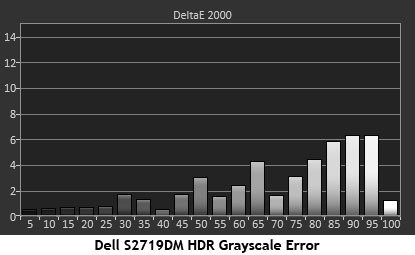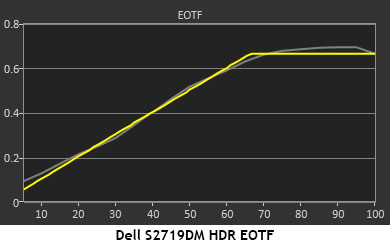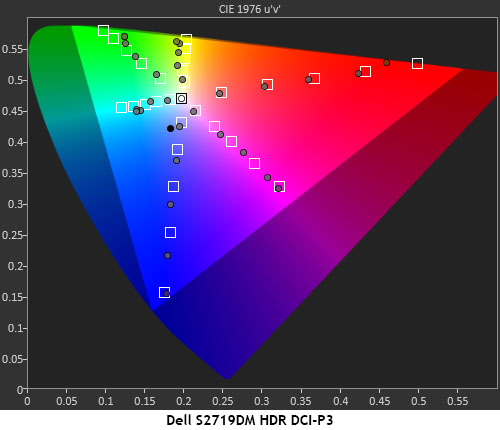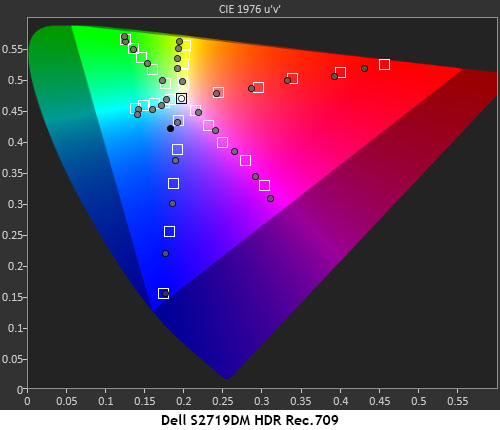Dell S2719DM 27" QHD HDR Monitor Review: Style Meets Performance
Why you can trust Tom's Hardware
HDR Grayscale, EOTF, & Color
To run HDR benchmarks, we add an HD Fury Integral to the signal chain to simulate HDR10 content from our Accupel DVG-5000 pattern generator. This enables us to measure the S2719DM's grayscale in 5% increments, track Electro-Optical Transfer Function (EOTF), an electronic value in content that specifies brightness displayed on the monitor, and calculate color gamut capabilities within a Rec.2020 container.
Grayscale Tracking & EOTF



The only available adjustment in HDR mode is contrast. This should be reduced slightly to avoid clipping highlight detail. We recommend a setting of 70%.
Other parameters are right where they should be for grayscale and EOTF. White balance is excellent at all brightness steps. A bit of green creeps in from 80-95%, but it’s unlikely anyone will see that in real world content. The EOTF tracks perfectly to and beyond the clip point at 65%.
Even though the S2719DM doesn’t have a lot of dynamic range, it meets HDR standards as well as any professional display.
Color Gamuts Within Rec. 2020



The S2719DM can’t get to the limits of DCI-P3 color, but it approximates the gamut well up to about 80% saturation. For most content, that means you’ll see some extra punch unless a scene is extremely bright, but the difference is small. We’re still aiming for Rec.2020, which is not yet out of the prototype stage. Few monitors can even hit 100% of DCI-P3. So, for this monitor to render 75% doesn’t mean it’s at a disadvantage. We would not consider the performance we measured a deal-breaker. It’s equally accurate to what we’ve seen so far from HDR/DCI displays.
Ultra HD Blu-rays
The S2719DM responded perfectly when we connected a Philips BDP-7501 Ultra HD Blu-ray player. Though the monitor is Quad HD (QHD), it will accept 3840x2160 signals up to 60Hz. It will not process 24p the same way as a TV, however. That isn’t a big deal except during camera pans when a little stuttering becomes apparent.
What we’re really looking for though is HDR and color quality. The monitor instantly and automatically switches to HDR mode when an HDR10 signal is present. You can still adjust the contrast slider, but not brightness, which is locked to maximum. Don't worry about excessive output. The 600-nit peak is rarely seen, and even then only in tiny highlights in some content. The images we saw were just right for a moderately lit room. Total darkness might be a little much, but Dell’s choices are appropriate overall.
Get Tom's Hardware's best news and in-depth reviews, straight to your inbox.
The extra color is subtle given that the S2719DM can’t quite reach the DCI volume of other monitors. That 75% volume means a slightly less saturated experience, but it is more vivid than what you’ll see in standard Blu-ray or gaming content.
Detail is clean and clear despite the down-rezzed signal. You’d never know that it isn’t Ultra HD at this screen size. Even close-up viewing doesn’t reveal any artifacts.
MORE: Best Gaming Monitors
MORE: How We Test Monitors
MORE: All Monitor Content
Current page: HDR Grayscale, EOTF, & Color
Prev Page Grayscale, Gamma & Color Next Page Viewing Angles, Uniformity, Response & Lag
Christian Eberle is a Contributing Editor for Tom's Hardware US. He's a veteran reviewer of A/V equipment, specializing in monitors. Christian began his obsession with tech when he built his first PC in 1991, a 286 running DOS 3.0 at a blazing 12MHz. In 2006, he undertook training from the Imaging Science Foundation in video calibration and testing and thus started a passion for precise imaging that persists to this day. He is also a professional musician with a degree from the New England Conservatory as a classical bassoonist which he used to good effect as a performer with the West Point Army Band from 1987 to 2013. He enjoys watching movies and listening to high-end audio in his custom-built home theater and can be seen riding trails near his home on a race-ready ICE VTX recumbent trike. Christian enjoys the endless summer in Florida where he lives with his wife and Chihuahua and plays with orchestras around the state.
-
Rdslw DELL >> anything, AT least in monitors. solid, bright, and just works no matter what and how you connect it. Easily best monitors I had.Reply -
AlistairAB I guess I just got unlucky. I ordered it right when it came out, clearly the best looking picture I've seen from a 1440p screen. But my black uniformity was awful with bleed everywhere. I ultimately bought the new Samsung 32" 4k monitor for $400 and am much happier.Reply
Nice to see though that Tom's got one with fantastic black uniformity, maybe I should have just ordered a second one..... -
AlistairAB The monitor is really beautiful and thin. Excellent build quality, much surpassing last year's thin design.Reply -
truerock I'm not sure I understand that 60Hz is a "Con"Reply
You can't get 120Hz in a 4k UHD monitor. That would require HDMI 2.1 which is not something you can buy for a Windows 10 PC at this time.
Am I missing something?
Is Tom's saying >>all<< 4k UHD monitors have a con of a maximum 60Hz? -
truerock OK... I'm reding the article again. It's just stupid. The subject is 4k UHD monitors. The reviewer is mentally confused and trying to compare 4k UHD monitors to other monitor form factors.Reply
The author needs to write a different article about the state of 4k UHD monitors in general compared to typical 1080p monitors or something like that. -
10tacle Reply21130801 said:I'm not sure I understand that 60Hz is a "Con"
You can't get 120Hz in a 4k UHD monitor. That would require HDMI 2.1 which is not something you can buy for a Windows 10 PC at this time.
Am I missing something?
Is Tom's saying >>all<< 4k UHD monitors have a con of a maximum 60Hz?
I had the exact same thought. The price point of this monitor and its features are extremely competitive if not class setting. You have to spend over $400 (USD) to get a faster 1440p 27" monitor, and that's not even including one for Freesync or G-Sync. Further, I am one who doesn't see the major performance improvement past a consistent 60Hz/60FPS gameplay experience or a 120Hz/120FPS experience.
This is why I've always overkilled on GPU power. I want to make sure the minimum frames in games don't dip down to near or below the 60FPS/60Hz sync limit. Also, the GPU doesn't have to work as hard. I've tried a G-sync 144Hz monitor and just didn't appreciate the cost difference vs. performance. I guess my eyes are getting older.
Anyway I've been very happy with my Dell U2713HM 1440p that is now five years old. It cost over $500 but for the time was top of the line. In fact I have four Dell monitors I've never had problems with any of them dating back to a 2000-built 19" Trinitron G420S CRT built by Sony. If my 1440p monitor dies, I'd snap one of these up in a heartbeat.
Also, I hope one day we can all have some sort of HDR standard because the different formats of it are not the same kind of tech and really not directly comparable:
HDR10 Dolby Vision
HLG
Advanced HDR
Off topic: I see my Dell G420S CRT monitor is selling on eBay for $450 plus! A photographer pro friend tells me that these old CRTs are still in high demand for their color reproduction. I think I just found my ticket to my next hardware upgrade. -
JamesSneed Reply21130801 said:I'm not sure I understand that 60Hz is a "Con"
You can't get 120Hz in a 4k UHD monitor. That would require HDMI 2.1 which is not something you can buy for a Windows 10 PC at this time.
Am I missing something?
Is Tom's saying >>all<< 4k UHD monitors have a con of a maximum 60Hz?
If only this was a 4k monitor you may have had a point. -
JamesSneed Reply21130815 said:OK... I'm reding the article again. It's just stupid. The subject is 4k UHD monitors. The reviewer is mentally confused and trying to compare 4k UHD monitors to other monitor form factors.
The author needs to write a different article about the state of 4k UHD monitors in general compared to typical 1080p monitors or something like that.
It's a QHD i.e 2K monitor. I don't think the author is the one confused. :pt1cable: -
JamesSneed I think the cons should list the lack of VESA, not a conn for everyone but then neither is 60 Hz. Personally on the spec chart I think VESA mountable should be there and if it was show the VESA mount size like 100x100 etc.Reply -
truerock Reply21132577 said:21130815 said:OK... I'm reding the article again. It's just stupid. The subject is 4k UHD monitors. The reviewer is mentally confused and trying to compare 4k UHD monitors to other monitor form factors.
The author needs to write a different article about the state of 4k UHD monitors in general compared to typical 1080p monitors or something like that.
It's a QHD i.e 2K monitor. I don't think the author is the one confused. :pt1cable:
Wow... do I feel stupid. I've been so focused on upgrading to 4k UHD that I forgot what QHD was.
In my limited brain space there is only 1920x1080p and 3840x2160 UHD. Everything else is just noise that I ignore. If I had noticed the article was about a QHD monitor I wouldn't have even read it.
Thanks for pointing out my stupidity. I was really confused about 60Hz being a "Con".
